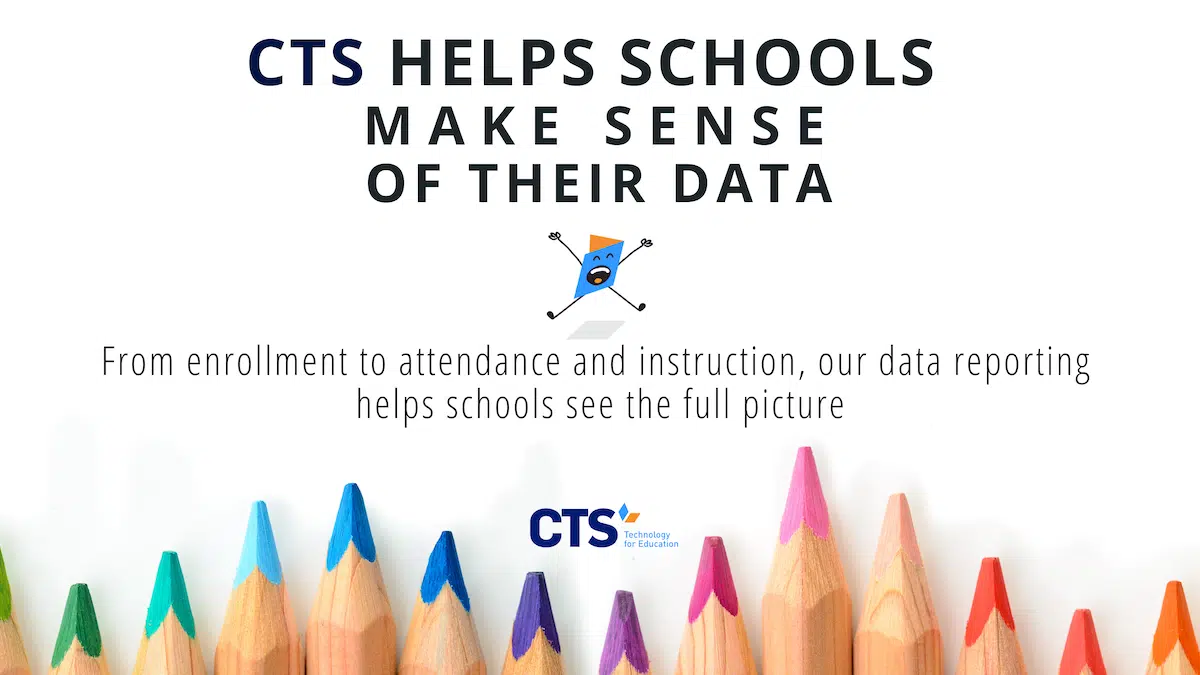Educational data reporting requirements have become increasingly complex.
Speak with any school administrator, and they’ll tell you data reporting, as well as state and local compliance requirements, consumes an inordinate amount of their time. Not only do state and local authorities often ask for datasets schools don’t regularly collect, but they also require schools to arrange their data in highly specific ways. For example, although a school might collect data on teacher experience (e.g., 4 years of full-time teaching experience), the school might not pair this data with a teacher’s alma mater, certification history, and other biographical information. Similarly, student data requirements might include demographic, academic, and behavioral information, all of which the school has on hand, but that “live” in different parts of the school’s data ecosystem.
CTS is here to help. While we may be known for our managed IT services, our team also has the experience and know-how to help schools organize, make sense of, and create systems to manage their otherwise disparate datasets. By getting a better handle on their student and staff data, schools can both support daily school operations and save administrators time in the process.
CTS’s data reporting tools can help you see the full picture.
While schools may regularly collect large amounts of student and staff data, they rarely integrate these datasets into a coherent whole. Doing so can not only ease the compliance burden on schools later down the road, but can also reveal insights that one dataset, on its own, wouldn’t.
CTS’s data dashboards address this issue, compiling high-level enrollment, attendance, demographic, behavioral, and instructional data into regularly updated overviews for school leadership. With a dashboard at their fingertips, school leaders can pinpoint fluctuations in their school’s enrollment, attendance percentages, and interim assessment scores with just a few clicks.
Having this data readily available can help school leaders identify potential growth areas, both instructional and non-instructional, and set goals based on their existing metrics. At a morning huddle, for instance, a school leader might recite the school’s current average on an interim assessment as he or she encourages teachers to boost students’ scores to a particular level during the next cycle.
Our reporting tools can bolster daily school operations.
Having a readily available, high-level overview of key school data can also help school leaders improve and reinforce their existing operational systems. For example, if a school leader begins noticing an increase in the number of students arriving late each day, she can meet with the school’s operations team to revise the current system for contacting students who fail to arrive on time.
Rather than a text message or email to the family member of the late student, the operations team might, instead, devote time to actually calling each student’s family when they arrive late, reinforcing the importance of timely arrival. After implementing the new system, the school leader can then see, in real time, whether the changes are having a positive impact on the school’s daily lateness percentage.
Only by having this data in one place, at her fingertips, can a school leader truly use it to improve and monitor the school’s operational systems. Rather than sorting through spreadsheets or the school’s SIS, the school leader can simply access the dashboard and quickly retrieve the information she needs.
CTS can also help schools identify a student information system (SIS) that meets their needs.
Even if a school isn’t in need of a data dashboard, CTS can still help leadership identify a student information system that makes sense for the school’s needs. Sorting through competing SIS bids and identifying the one system that matches school leaders’ desires can be tricky, especially if school leaders have little knowledge of the SIS market beyond the systems they’ve used in the past.
The choice of an SIS is particularly critical for new schools: getting staff members invested in regularly using and navigating an SIS is a herculean task. The last thing a school leader wants to do is shift systems in year two due to the shortcomings of their chosen system for year one. Our team can meet with school leadership, identify a checklist of items the school needs in its SIS, and make recommendations based on our experience in the field.
At CTS, we use data reporting tools to help schools accomplish their unique missions.
At the end of the day, school leaders use educational data to accomplish their unique missions. School attendance data, teacher experience reporting, and interim assessment outcomes are useful because they allow school leaders to understand the factors that impact student achievement. Schools with robust, integrated data systems can quickly identify areas of growth at their school and adjust their systems to support student learning. Contact CTS today to learn more about our data reporting systems and how we can use your school’s data to accomplish your unique mission.




